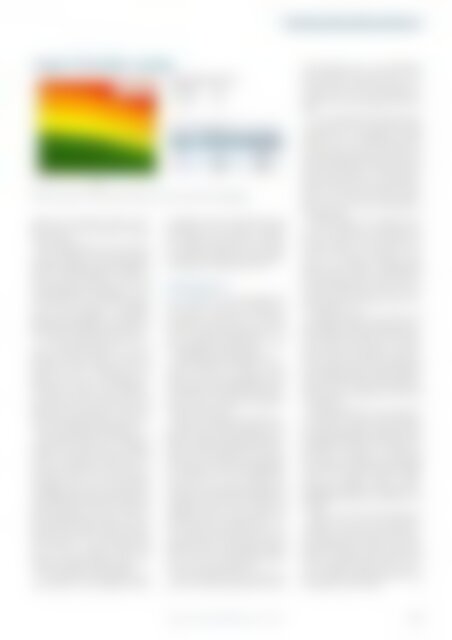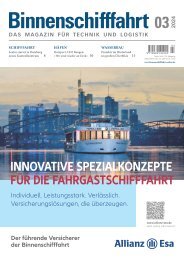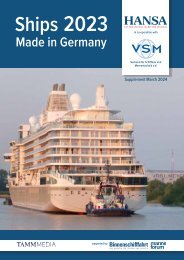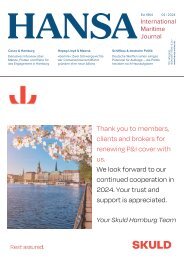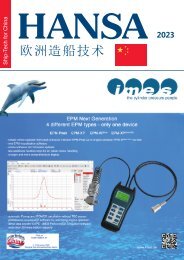HANSA 02-2023
WISTA Germany · Ship Efficiency · CII · Weather Routing · Neubau »Coriolis« · Future Fuels · Klima-Risiko in Häfen · Brandschutz · Hydropen · MPP-Flotte · Deck Carrier · Shortsea-Schifffahrt
WISTA Germany · Ship Efficiency · CII · Weather Routing · Neubau »Coriolis« · Future Fuels · Klima-Risiko in Häfen · Brandschutz · Hydropen · MPP-Flotte · Deck Carrier · Shortsea-Schifffahrt
Sie wollen auch ein ePaper? Erhöhen Sie die Reichweite Ihrer Titel.
YUMPU macht aus Druck-PDFs automatisch weboptimierte ePaper, die Google liebt.
SCHIFFSTECHNIK | SHIP TECHNOLOGY<br />
Weather routing can be used to extend a ships »life« at certain score before downgrading<br />
going to be successful in terms of CII,«<br />
says research and innovation manager<br />
Roberto Vettor.<br />
The sailing speed and CII are also only<br />
weakly correlated, since reduced speed<br />
means reduced power and consumption,<br />
but also reduced distance covered. A<br />
much stronger correlation can be found<br />
when looking at the sailing time. So, not<br />
an efficient hull, but an efficient voyage<br />
and not slow steaming as standalone<br />
measure but integrated in a wider plan,<br />
eliminating the wasted time, can lead to a<br />
better score, according to Vettor’s data.<br />
»A unidirectional approach may not<br />
lead to the desired result. It is a combination<br />
of factors, efficiency of hull and<br />
propulsion system, sailing speed, time<br />
spent in port or at anchorage, consumption<br />
for boilers and auxiliaries,«<br />
says Roberto Vettor, Senior R&I Manager,<br />
Napa. He also stresses that crew and<br />
operator must be proactive. »They have<br />
to plan the schedule and the route, monitor<br />
the voyage and reduce idling time.«<br />
Napa also looked at the impact of<br />
weather routing on the CII. The company<br />
analyzed over 1,400 voyages of 90 bulk<br />
carriers (30 Handysize, 30 Panamax, 30<br />
Capesize) in 2<strong>02</strong>1. The routes were analyzed<br />
and CIIs for the vessels calculated<br />
accordingly. The routes were then optimized<br />
keeping the same arrival time and<br />
using the forecast data that would have<br />
been available to the vessels at the time.<br />
The average CII improvement is 6.1 % for<br />
Handysize vessels that conduct relatively<br />
short voyages, 5.7 % for Panamax ships<br />
and 7.5 % for Capesize vessels that<br />
usually sail longer distances where the<br />
impact of weather routing is higher.<br />
»We found that by using weather routing,<br />
a ships life in one CII grade could be<br />
extended by two to three years before being<br />
downgraded. This can help to postpone<br />
more expensive interventions to improve<br />
the technical performance of the ship,«<br />
says Vettor. One could say that bad weather<br />
and idling are both poison for the CII.<br />
Predicting the CII<br />
So, is a vessel’s CII score predictable after<br />
all? »If you are aware, you are halfway to<br />
the solution,« says Vettor. »If we know<br />
what the score will be at the end of the<br />
year, we can plan the right actions or – if<br />
we are already in a good position – enjoy<br />
more flexibility in the operations.«<br />
Predicting and managing the CII is especially<br />
important in charter parties<br />
where the owner responsible for his<br />
vessels’ rating is not operating them himself.<br />
He has to rely on the charterer to operate<br />
his assets as efficient as possible to<br />
maintain a good score.<br />
Bimco, the world’s largest shipping association,<br />
has therefore adopted a standard<br />
»CII clause« for charter parties to<br />
help the industry implement the requirements<br />
set by the IMO. The key point is<br />
that the clause transfers the responsibility<br />
for compliance with the CII Regulations<br />
from the owner to the charterer. The<br />
charterer has to operate and employ the<br />
vessel in a manner consistent with the CII<br />
regulations. And he has to operate and<br />
employ the vessel in a manner which will<br />
not permit the »C/P Attained CII« – i.e.<br />
the vessel’s CII attained at the start of the<br />
year or the delivery date if this was in the<br />
middle of a year – to exceed the »Agreed<br />
CII«. (i.e. the CII value which the parties<br />
agree in the clause will be met).<br />
»The CII agreed between owner and<br />
charterer is measured in gCO 2<br />
/dwt*nm.<br />
The projected CII is an extrapolated<br />
value until the end of the year or the<br />
charter period. This means that an accurate<br />
and easy tool for projection is<br />
needed«, says sales manager Ossi Mettälä.<br />
It is recommended that the agreed CII<br />
is less than the one required by IMO,<br />
middle level or a rating grade C, getting<br />
stricter every year. If the projected CII<br />
deviates from the agreed CII, the owner<br />
can ask the charterer to provide a plan to<br />
improve performance. Overall, cooperation<br />
between parties is encouraged to<br />
identify potential improvement areas.<br />
Bimco also mentions voyage optimization<br />
and active voyage monitoring to<br />
help the parties.<br />
»Vessels operate in a complex multidomain<br />
environment interfacing with<br />
sea and weather, business aspects and<br />
technical aspects. The common nominator<br />
for all these parameters is the<br />
vessel,« says Mettälä. »Understanding<br />
the ship helps to draw conclusions between<br />
costs and efforts. At the core of the<br />
continuous improvement cycle is reviewing<br />
the impact of decisions made. The<br />
same applies to CII.«<br />
Cooperation between the owner and<br />
the charterer requires a common and reliable<br />
platform to predict the performance<br />
until the end of the year or charter<br />
period. Napa’s CII Simulator was developed<br />
to assist the parties for keeping the<br />
vessel’s carbon intensity under the agreed<br />
level. All known future voyages can be included<br />
as well as dates for underwater<br />
hull cleaning to calculate the CII at the<br />
end of the year.<br />
»Routing should be more than just<br />
safety. Weather routing is an integral part<br />
of reducing emissions. Taking weather<br />
routing from good to great requires more<br />
than human experience. The amount of<br />
parameters is countless, most affecting<br />
the voyage KPIs differently. Optimizing<br />
for profit, CII or fuel consumption might<br />
yield very different results. Understanding<br />
the sensitivity of the outcome to<br />
the different decisions is valuable,« says<br />
Mettälä.<br />
What to do now? All vessels should be<br />
monitored for their fuel performance<br />
voyage by voyage, the experts agree. Before<br />
applying the CII clauses for charter<br />
parties, the owner needs to know the<br />
realistic CII rating for a particular vessel<br />
to be compliant. »And then you need to<br />
focus on energy efficient operations now<br />
immediately,« says Mettälä.<br />
fs<br />
<strong>HANSA</strong> – International Maritime Journal <strong>02</strong> | 2<strong>02</strong>3<br />
49


